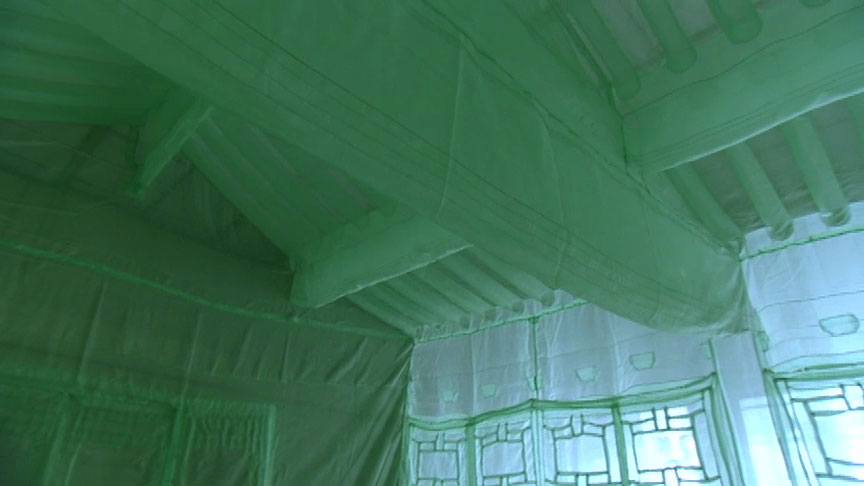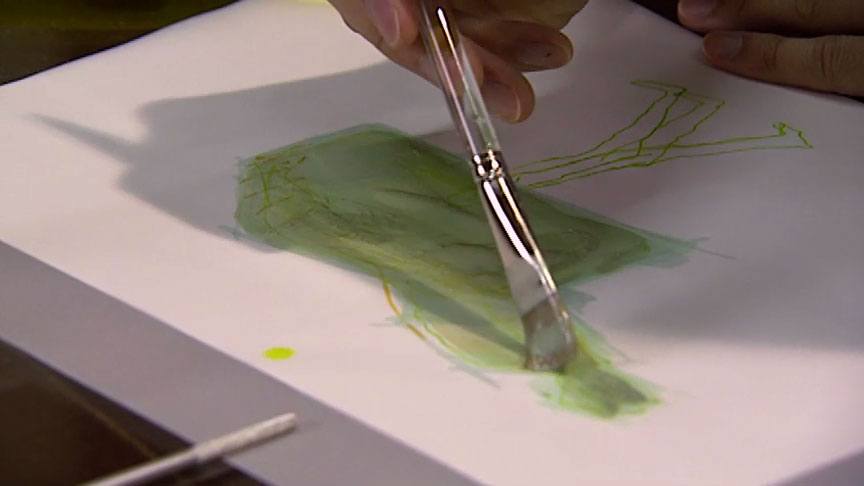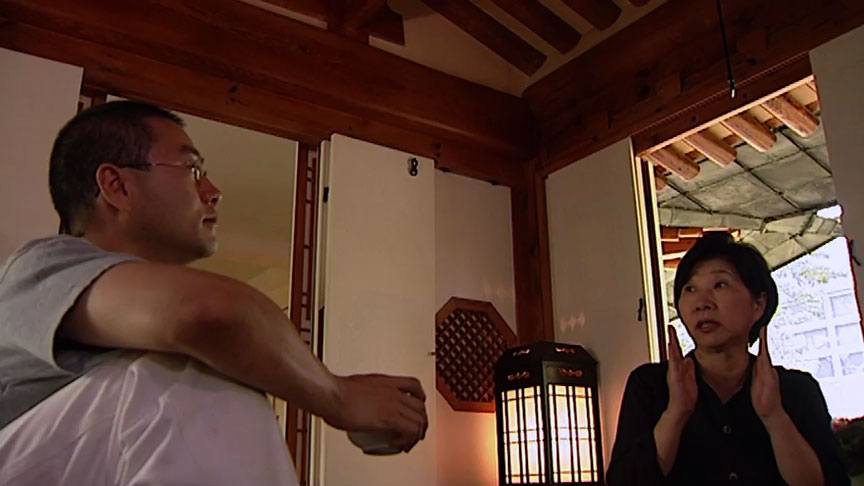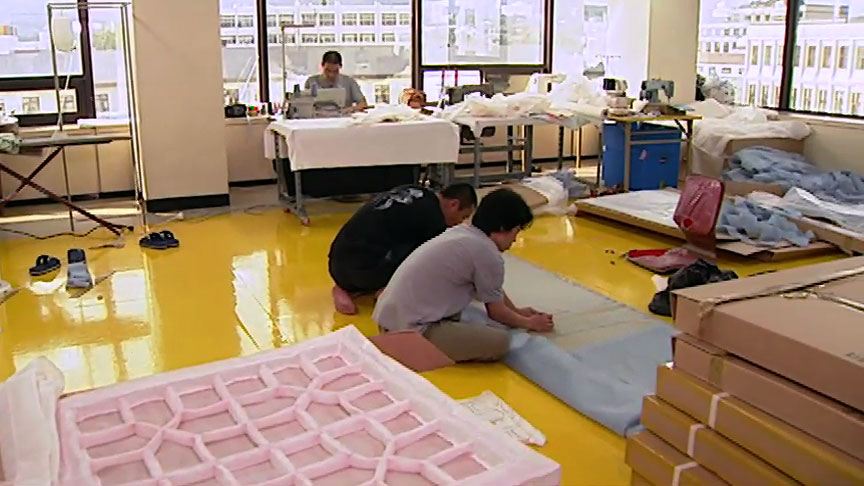Interview
“Seoul Home/L.A. Home”—Korea and Displacement

Do Ho Suh. Seoul Home/L.A. Home/New York Home/Baltimore Home/London Home/Seattle Home, 1999. Installation view at the Seattle Asian Art Museum, Washington, 2002. Collection of the Museum of Contemporary Art, Los Angeles. Courtesy the artist and Lehmann Maupin Gallery, New York. Production still from the Art in the Twenty-First Century Season 2 episode, Stories. © Art21, Inc. 2003.
Do Ho Suh discusses the role of place in his work, and his 1999 installation piece Seoul Home/L.A. Home/New York Home/Baltimore Home/London Home/Seattle Home.
ART21: What was your training in art in Korea like? What did you study?
SUH: It was a traditional painting technique that I learned there. Basically, ink on rice paper, mostly black and white, with a very flexible brush. For the first through the second year of college, you train how to use your brush well and how to grind your ink well—very ritual kinds of things. And then once you get comfortable with the brush—in other words, once you reach the point where you can have a really good-quality line—then you can actually paint or draw what you want. So, it was a rather boring process.
And there were many different classes. For example, like, calligraphy—I’m really bad at that, and I’m probably worse than you. But I was able to sort of get around it. It was senior year, I think, when I was able to do something I wanted, more creative stuff. Teachers didn’t allow us to really explore many different things. That’s something that I really regret. We never had a crit, and it was only one direction—from teacher to the students. There was no exchange or dialogue between the teacher and student. If the teacher says something, then you just have to follow that.
So, it was very awkward and, at the same time, interesting when I first came to the United States. One thing was my English. But at the same time, I wasn’t really trained to express my feelings or thoughts on art. I was not trained to do that, at all. So, it took me an entire semester to just say, “I like this work” or “I don’t like this work.” And then, gradually, I started to learn how to talk about my art. And ironically, I had never talked about my art in Korean before. Even though my English is not good, I think I feel more comfortable actually talking about my work in English than in Korean. That’s something that I find interesting. So, when I give a lecture in Korea, for example, I realize myself actually translating my thoughts in English into Korean. So, yeah, it’s a funny thing.

Do Ho Suh at his parents’ home, Seoul, Korea, 2002. Production still from the Art in the Twenty-First Century Season 2 episode, Stories. © Art21, Inc. 2003.
ART21: Is language the only thing that’s been a real challenge for you?
SUH: When I go back to Korea…Seoul is a very crowded city, and on the street, people bump into each other. And somebody could just hit your shoulder, and that’s normal, so nobody complains about it. But I realize that’s different, here. And when I go back to Korea, when somebody touches my body, I get really annoyed. So I think, since I’ve spent eleven years here in the States, my perception of this personal space—this dimension—has changed. So, that’s something that I found quite interesting.
ART21: And that’s related to your evolving work, Seoul Home/L.A. Home.
SUH: I would say the Korean house project started from this need to fulfill a certain desire, when I graduated from [Rhode Island School of Design]. I was in New York for a year before I went to grad school. I was living on 113th Street, near Columbia, and my apartment building was right across the street from the fire station. And it was really, really noisy, and I couldn’t sleep well. And I was thinking, “When was my last time to have a really good sleep?” And that was in a small room, back in Korea. And I wanted to bring the house, somehow, to my New York apartment. So, that’s where everything started.
So, I started to think about the materials and the practicality of that project or the possibility of the project. And the choice of fabric came very naturally. Literally, I was going to install that fabric Korean house in my New York apartment, but apparently my apartment was much smaller, so I couldn’t really do it. But it turned out to be a project, later. I did do a test because it was a fairly large project for me to tackle at that time. I did the test in my small studio in New York, in muslin cloth. And it worked. But I didn’t have time and money to actually do the Korean house project until 1999.
ART21: What was that experience in your studio about?
SUH: The experience was about transporting space from one place to the other—a way of dealing with cultural displacement. And I don’t really get homesick, but I’ve noticed that I have this longing for this particular space, and I want to recreate that space or bring that space wherever I go. So, the choice of the material, which was fabric, was for many reasons. I had to make something that’s light and transportable, something that you can fold and put in a suitcase and bring with you all the time.
That’s actually what happened when I first made that piece, the Korean house project. I brought that piece in my suitcase—two suitcases—to L.A., where I showed that piece for the first time, at the L.A. Korean Culture Center. It was about challenging this notion of site-specificity because the piece was made inside the house. Everything was made in that space, so it was a site-specific installation. But once you take that piece down from its own site and display and transport it in a different place, this idea of the site-specific becomes highly questionable and [debatable]. And that’s what I was really interested in, because in my mind, I think this notion—home—is something that you can infinitely repeat.

Do Ho Suh. Seoul Home/L.A. Home/New York Home/Baltimore Home/London Home/Seattle Home, 1999. Installation view at the Seattle Asian Art Museum, Washington, 2002. Collection of the Museum of Contemporary Art, Los Angeles. Courtesy of the artist and Lehmann Maupin Gallery, New York.
ART21: What do you mean by that?
SUH: I mean, at some point in your life, you have to leave your home. And whenever you go back, it’s just not the same home anymore. I think home is something that you carry along with your life. That’s what I mean by [saying] it’s something that you can repeat over and over again. I just dealt with that issue visually. In a physically [minimal] way, it’s this light fabric thing that can recreate this ambiance of a space. I didn’t want to sit down and cry for home. I wanted to more actively deal with these issues of longing. I decided not to be sad about it. I just want to go with it. I just want to carry that with me, you know, all the time.
I think the process of making the Korean project has a really important meaning to it. Because, in order to make that piece, you have to measure every inch of the space. And you really get to know the space, and you often find little marks that you did when you were a kid, and that brings all the memories of your childhood. And when you go through that process, this space becomes part of you, and you really feel like you know it. It’s in you, and you can actually leave home without any kind of attachments. Does that make sense? I mean, I would say it’s one way of dealing with homesickness.
I had a conversation with a friend of mine, the other day, [who said]: “It seems like it’s a lot of sacrifice for you, that you have to deal with the cultural barrier, language, you know—it’s a kind of constant thing. And at the same time, you have this homesickness.” She asked me whether I have homesickness or not. I told her that I don’t have that much homesickness, but if there’s something I miss, it’s probably my parents’ house in Korea and my mom’s home cooking. So, I decided to learn her recipe, everything, and just practice that recipe with her every time I go back to Korea and then make those recipes mine. And then it becomes my recipe, so I don’t really have to miss that, because I can make that. And then I decided to make this into some kind of project: I want to make my mom’s cookbook. It’s a very simple thing. But in a way, it’s kind of the same project as my Korean house project, but in a different kind of form.

Do Ho Suh at his parents’ home, Seoul, Korea, 2002. Production still from the Art in the Twenty-First Century Season 2 episode, Stories. © Art21, Inc. 2003.
ART21: And where is home, now?
SUH: It’s really a tough question, actually. Like I said before, once you leave home, then it’s not the same anymore. I mean, you miss certain things, but whenever you go back, it doesn’t meet your expectation because you change, and things change over there, too. Intrinsically this awkwardness and unfamiliarity, being in different cultures, will remain with me for the rest of my life. But I found, every time I come back to New York, I feel like certain things are very comfortable because I’m surrounded by more strangers than in Seoul. Somehow that makes me more comfortable. So, I can relax more, here. I’m telling my friends now, “Oh, New York feels like my home now.” Just because of that. So you, too, can have more quiet time here.
ART21: Do you think of yourself as an international voyager?
SUH: Well, at least I have means to travel. At least I can say I’m living in this era, that these means to travel are available. So, if I want, I can go back to my home, to my parents’ place. It’s not that much of a problem, I think. But I wouldn’t say that I’m an international voyager or whatever; not yet, I don’t think. But I spend a lot of time on the airplane. And I’m not in one place—just in between, definitely. That’s how I feel.
ART21: What prompted you to move to the United States?
SUH: Once, my fortune-teller told me that I have five horses: five horses in my fortune, in my life. That means that I travel a lot. I’m destined to leave home and live somewhere else and travel to many places: that’s a story. Something that I realized fairly recently: I think I also wanted to leave home because of my father. He was a successful painter, very successful. I think I was doing really well back there, too. But I think somehow I felt that his fame overshadowed me, and I wanted to do my own things without any kind of attachment to my family background or my father. So, I think that was probably the main reason, but I wasn’t really sure.
I didn’t really realize that in Korea, but now I think it was probably the main drive to come here. Like, whatever I do, people always connect me to my father and, you know, this is through village kid and so on and so forth. I think more independently, here, because—whatever I do here—if I fail, it’s all my fault. I kind of like that idea. And if I make it, then that means I started from scratch all by myself. And I think that’s more meaningful than doing something in Korea. So, I think that’s it. And I had other reasons to come, but that was more related to my first marriage. My ex-wife was Korean but born in the States, and she was studying here, so it was a pretty natural way to come. Right after we married, I came here.

Do Ho Suh at work, Seoul, Korea, 2002. Production still from the Art in the Twenty-First Century Season 2 episode, Stories. © Art21, Inc. 2003.
ART21: Can you talk about the process of making the Korean house project?
SUH: The Seoul Home/L.A. Home project is actually the first kind of project that I’ve collaborated on with so many people—and not just numbers of people, but also people from different fields. My mom helped me to find right fabric. She introduced me to many different fabric manufacturers. So, for that piece, the fabric was custom-made. I couldn’t find the right color, so we produced for that specific color. And also, she knows a lot of seamstresses, old ladies—“national treasures.” (It’s kind of an awkward term. I’m just translating literally; in Korea, we call people who keep traditional techniques and craftsmanship alive “national treasures.”) And those old ladies helped me to make small ornaments on the pieces. And they taught me how to sew certain seams. I mean, it’s hard to see the difference, but there are many different kinds of sewing. And my main assistant—he studied industrial design at college, and he worked with me at the planning stage.
So, there were a lot of people involved, always. I do something always totally different each time. And for example, those seamstresses—they only make traditional dresses and had never done these things, like this. So, at the beginning, it was kind of difficult to explain the scope of project, but they catch up so [quickly]. And they really got into the project—and I see that all the time—because it’s something that they don’t do normally, so I think they found it interesting. I like that, when it happens.
ART21: What is the significance of the color of the piece?
SUH: The color of Seoul Home/L.A. Home is a kind of light jade color, or celadon color. I just picked the color from the ceiling paper in the traditional Korean house. In the traditional house, you hang white papers on the wall. And on the ceiling, you have this sky-blue- or jade-colored wallpaper. It symbolizes the sky or universe. That house is for the scholar, so when they study in that room, the color allows them to think about the universe or a bigger space, things like that. So, I used that color for my piece.

Do Ho Suh at his parents’ home, Seoul, Korea, 2002. Production still from the Art in the Twenty-First Century Season 2 episode, Stories. © Art21, Inc. 2003.
ART21: The scholar’s house was the original model for the piece? What was it like, visiting that original house?
SUH: Yes, my parent’s house was modeled after this civilian-style scholar’s house, which was built in a palace complex in the early nineteenth century. And my house project, Seoul Home/L.A. Home, is the replica of the interior of my parent’s house.
I was walking with my mom—and that was my first visit since my parents and me and my brother first visited that palace complex in the early ’70s. So, we’re talking about changes, because it was a very memorable experience for me. (We went there to measure the original house in the palace complex with a couple of engineers and architects. We took the entire day to measure it.) And my mom and I talked about this wild pear tree in the garden; it was there in the ’70s, and still it was there, and so we talked about that. And I told her that the house looked much smaller than I thought; because I was little, so everything looked, probably, bigger.
And most of the time, I was upset because the house wasn’t maintained well enough. My mom is involved with renovating that palace complex, and she has to face a lot of obstacles, mostly bureaucratic problems and things like that. And we talked about that. And because my parent’s house was just part of that complex—so much smaller, just one section of the house was the master’s quarters—it was interesting to see that segment in the larger context.
This interview was originally published on PBS.org in September 2003 and was republished on Art21.org in November 2011.



